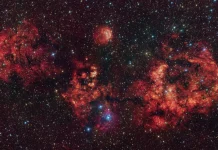Recent research searches through the origins of present-day cosmic structures by analysing over one million galaxies
The study challenges traditional approaches by incorporating the shapes of galaxies, highlighting the nature of primordial fluctuations and expanding the realm of cosmological research.
The ΛCDM model
The established ΛCDM model, based on precise observations of the cosmic microwave background (CMB) and large-scale structure (LSS), suggests that primordial fluctuations in the early universe triggered the formation of celestial bodies, including galaxies and galaxy clusters.
These fluctuations grew over time through gravitational forces, eventually creating dense regions of dark matter known as halos. The collision and merging of these halos led to the formation of galaxies.
Studying the shapes of galaxies
Originally, analyses focused on the spatial distribution of galaxies as points, but the recent study led by Toshiki Kurita and Professor Masahiro Takada, both associated with the Kavli Institute for the Physics and Mathematics of the Universe (Kavli IPMU), introduces a different approach.
By studying the shapes of galaxies, the researchers extracted key statistical information by combining spectroscopic data on galaxy distribution with imaging data on individual galaxy shapes.
The team examined the spatial distribution and shape patterns of approximately one million galaxies from the Sloan Digital Sky Survey (SDSS), the largest galaxy survey to date.
They discovered a statistically significant alignment of the orientations of galaxies more than 100 million light-years apart, indicating correlations between galaxies with seemingly independent formation processes.
Kurita, now a postdoctoral researcher at the Max Planck Institute for Astrophysics, expressed excitement about the research, saying, “There are few precedents for research that uses galaxy shapes to explore the physics of the early universe. The process, from idea construction to data analysis, was a series of trial and error, but I am glad that I was able to accomplish them during my doctoral program. I believe that this achievement will be the first step to open up a new research field of cosmology using galaxy shapes.”
The universe’s rapid expansion
The detailed investigation of these correlations confirmed their consistency with predictions by inflation, a cosmological model explaining the universe’s rapid expansion. The correlations did not exhibit a non-Gaussian feature of primordial fluctuations.
Professor Takada highlighted the significance of the research, stating, “It’s a wonderful research achievement in which we developed a method to validate a cosmological model using galaxy shapes and galaxy distributions, applied it to data, and then tested the physics of inflation. We can expect to open up further areas of research using the Subaru Prime Focus Spectrograph.”











